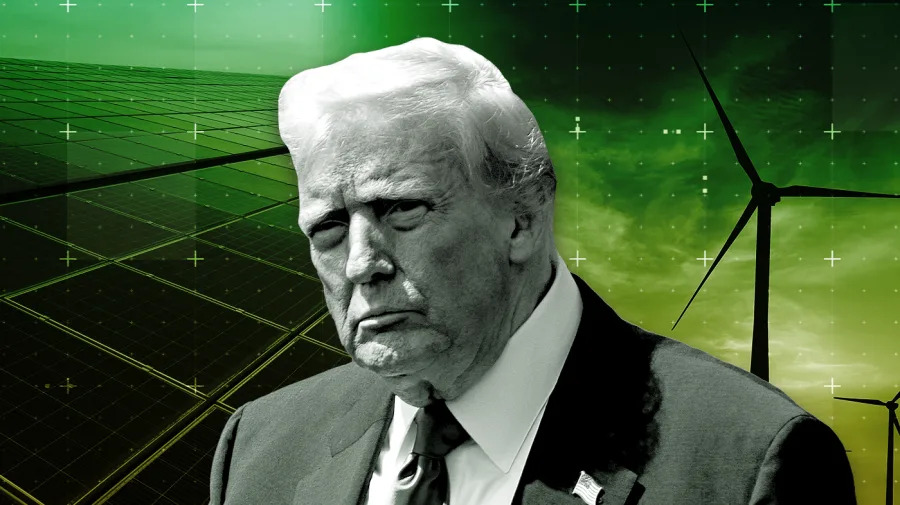
The Trump administration’s rollback of clean energy initiatives and focus on expanding U.S. domination of natural gas exports is set to transform U.S. and global energy markets for decades to come.
Some experts warn U.S. divestment from clean energy risks increasing consumer prices, slowing down innovation and ultimately undermining competitiveness in key industries.
These worries are exacerbated by predictions that energy usage and prices are expected to skyrocket in the coming years.
“If you are concerned about resource adequacy for meeting growth in electricity demand, you want all hands on deck, right?” said Jon Elkins, a senior research scholar at the Center on Global Energy Policy.
“You would want all technologies to be part of the solution set, and the technologies that can be built out the fastest … are wind and solar and batteries.”
President Trump, however, has taken a different approach.
“Any State that has built and relied on WINDMILLS and SOLAR for power are seeing RECORD BREAKING INCREASES IN ELECTRICITY AND ENERGY COSTS. THE SCAM OF THE CENTURY!” he wrote on Truth Social on Wednesday. “We will not approve wind or farmer destroying Solar. The days of stupidity are over in the USA!!!”
Since his return to the White House, Trump has aimed to increase the production and exports of fossil fuels such as liquefied natural gas (LNG), and to boost nuclear and geothermal energy to surge supply.
His landmark budget bill enacted major cuts in the growing clean energy sector, especially in wind and solar energy, by phasing out green energy subsidies implemented by former President Biden’s Inflation Reduction Act (IRA).
For Elkins, who was also an Obama-era assistant secretary for international affairs at the Energy Department, Trump’s efforts to “unleash” American energy are incomplete without renewables.
“What is certainly at stake is the role that the U.S. carves out for itself in the future and in a world of rapid changes in energy technology,” he said. “Do we want a position in the U.S. to be an innovator, a market maker, a market leader, a solution provider or a laggard?”
“Because right now, the actions that have been taken by the Trump administration are really ambiguous,” Elkins added.
Changing the energy mix
The renewable energy industry accounted for just more than 20 percent of the U.S.’s energy production in 2023.
Under Biden’s IRA, about 40 percent of the country’s electricity was expected to come from renewable energy sources by 2030, according to the American Clean Power Association.
But with Trump’s reversal, the share of clean energy contributions to the U.S. energy grid are projected to shrink anywhere between 57 and 62 percent in the next five to 10 years, per the Rhodium Group, an independent research organization.
As part of his energy plan, Trump ended Biden’s 2024 pause on natural gas exports. The prior administration halted LNG exports and projects in its efforts to kick-start a transition to clean energy.
“In stark contrast to Biden’s ban on LNG exports, President Trump is leveraging every tool of government to boost natural gas production and LNG exports,” White House spokesperson Harrison Fields told The Hill.
“This stands as a major priority and success for President Trump, as we’ve already witnessed significant demand and interest from our trading partners for more American LNG,” he added.
The Council of Economic Advisors calculated that the country’s gross domestic product could rise by an additional 0.56 to 1.90 percent annually by 2035, thanks to Trump’s move to restart exports.
Still, energy security experts warn a less diverse energy mix has wide-ranging consequences.
A July report from SAFE, a nonpartisan energy security think tank, and the Energy Security Leadership Council argues a diversified domestic industry will allow the U.S. to curtail its reliance on foreign countries for oil and other energy sources.
The report argues that a “shift to new technologies” is “critical to national security, as dependence on a volatile and manipulated oil market constrains U.S. foreign policymaking and affects the flexibility and activities of the military.”
“Unlike fossil fuels, renewables do not require fuel inputs, making them immune to price volatility,” it reads.
The American Petroleum Institute, the biggest oil and natural gas lobbying group, argued that clean energy and the president’s emphasis on LNG can be complementary.
“Natural gas has such an important role to play in reliability for the power grid here in the U.S. for energy security. It is also a natural complement to supporting renewables on the grid,” said Rachel Fox, the institute’s director of policy, economics and regulatory affairs.
“We do want to see natural gas play a role pretty much everywhere where it can, given that we can produce it abundantly, at low cost, and we can export it abroad to support international energy security,” she added.
Skyrocketing electricity demand
Rising prices are a critical point of concern for American consumers, as electricity consumption is expected to reach an all-time high and skyrocket in the coming years. By 2040, demand is slated to increase anywhere from 35 to 50 percent, according to American Clean Power.
At the end of July, electricity prices were 5.5 percent higher on average than the same month the previous year. One reason for that increase is the expansion of energy-intensive industries, such as data centers and artificial intelligence, which the administration has invested heavily in.
“We all agree in Washington that we expect there to be growing demand for electricity,” Avery Ash, SAFE’s senior vice president, told The Hill. “The only immediate solutions are the sorts of renewable energy such as wind and solar that are both quick to deploy and already in the interconnection queue.”
Democrats on Capitol Hill this month railed against the administration’s renewables rollback, slamming Trump over high energy prices.
“While energy demand surges, your policies are strangling America’s cheapest and quickest-to-deploy sources of energy — solar and wind — by hiking costs, creating insurmountable permitting hurdles and injecting uncertainty into the market,” a group of senators wrote.
Fox disagrees. She argued that natural gas “has the best chance of meeting the type of demand that we’re going to see coming in the next decade,” acknowledging growing demand and rising energy prices.
Still, Elkins said de-emphasizing renewables makes “the whole job harder.”
“We are making it harder to help hyperscalers develop capacity for artificial intelligence and other data centers here in the U.S. We’re making it harder to avoid household electricity cost increases,” Elkins added. “We’re making it harder to do other new manufacturing that is happening across the U.S.”
Rollbacks risk U.S. competitiveness
Wayne Gray, a professor of economics at Clark University, told The Hill that U.S. companies have less of an incentive to develop new clean energy products because of Trump’s policies, and are likely to fall behind on the global stage.
“That leaves the door open, whether that’s to European firms or to Chinese firms, to leapfrog a bit ahead and then potentially be in a position to have much more control over those markets,” he said.
The administration’s move to gut offshore wind projects — a booming market — has downstream effects on other critical industries, including shipping and steel, according to Elkins.
“The question on the table now is what are the industries of the future, and where do we see ourselves going? What are going to be the sources of U.S. economic competitiveness going forward, the sources of U.S. job creation going forward?” he asked.
Still, some private companies have doubled down on the emerging renewable market.
Ford Motor Co., for example, plans to invest nearly $2 billion to develop more affordable midsize electric vehicles (EVs) after Trump’s spending law nixed EV tax credits.
“And this new vehicle built in Louisville, Kentucky, is going to be a much better solution to anything that anyone can buy from China,” Ford CEO James Farley said.
Even if the private sector continues to invest in clean energy technology, Ash worries that if there is not enough electricity to meet demand, sectors such as artificial intelligence or EVs will confront hurdles.
“The real question is not how do we meet the power needs of today, but how we meet the energy power needs of tomorrow,” said Ash.
If the U.S. does not meet those needs, he added, “It’ll be very hard for us to compete globally, when we think of all the industries the U.S. wants to be a leader on going forward, the U.S. will not be competitive.”
Copyright 2025 Nexstar Media, Inc. All rights reserved. This material may not be published, broadcast, rewritten, or redistributed.
For the latest news, weather, sports, and streaming video, head to The Hill.








Comments